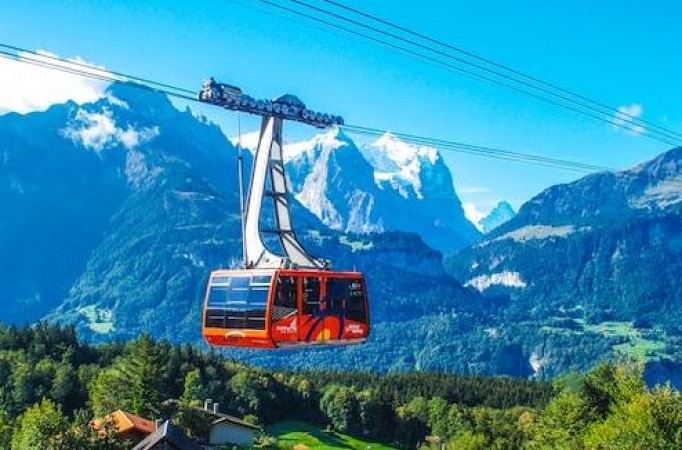
In bustling cities around the world, where traffic congestion is a constant challenge, innovative modes of public transportation are gaining popularity. Cable cars, also known as ropeways or aerial tramways, have emerged as a unique and efficient way to transport people through hilly or densely populated areas. This article will explore cities globally that have successfully integrated cable cars into their public transportation systems, offering residents and visitors an extraordinary way to navigate their urban environments.
History of Cable Cars
The history of cable cars dates back to the 19th century when they were first developed as a means to transport goods and people in mountainous regions. The concept evolved over time, with the introduction of cable propulsion systems and the establishment of urban cable car networks. Notably, San Francisco's cable car system, established in 1873, remains one of the most iconic and historic cable car systems in the world.
Benefits of Cable Cars in Urban Transportation
Cable cars offer several advantages over traditional modes of urban transportation. Firstly, they can navigate steep slopes and hilly terrains where other vehicles may face difficulties. This makes them particularly useful in cities with challenging topography. Additionally, cable cars have a small physical footprint, requiring minimal space for their infrastructure, compared to other forms of public transportation like buses or trains. They are also energy-efficient, often powered by electricity, making them a greener alternative.
Iconic Cable Car Systems
San Francisco, United States
San Francisco's cable car system is an integral part of the city's identity and a major tourist attraction. The system operates three lines, namely Powell-Hyde, Powell-Mason, and California Street, covering popular destinations such as Fisherman's Wharf, Union Square, and Chinatown.
La Paz, Bolivia
La Paz boasts the world's highest urban cable car network, known as Mi Teleférico. This system has revolutionized transportation in the city, connecting various neighborhoods and alleviating traffic congestion. Traveling by cable car in La Paz provides breathtaking panoramic views of the surrounding mountains.
Medellín, Colombia
Medellín's Metrocable system is an exemplary model of cable car integration in an urban setting. It serves as an important mode of transportation for residents living in the city's hilly neighborhoods. The Metrocable has not only improved mobility but also fostered social inclusion and economic development in previously marginalized areas.
Hong Kong, China
Hong Kong operates a cable car system called Ngong Ping 360, which transports passengers to the famous tourist attraction, the Tian Tan Buddha, on Lantau Island. This cable car journey provides visitors with stunning aerial views of the island's natural landscapes.
Lisbon, Portugal
Lisbon's cable car system, known as the Elevador da Glória, is an iconic feature of the city's transportation network. It connects downtown Lisbon with the Bairro Alto neighborhood, offering a convenient and scenic way to reach the elevated district.
Cable Cars as Tourist Attractions
Beyond their functionality as a mode of transportation, cable cars have become popular tourist attractions in many cities. Visitors are drawn to the unique experience of riding cable cars, enjoying panoramic views, and capturing memorable photographs. Cable car networks often incorporate stops at major tourist destinations, further enhancing their appeal to travelers.
Environmental Sustainability of Cable Cars
Cable cars contribute to environmental sustainability by reducing reliance on fossil fuel-powered vehicles and mitigating traffic congestion. Their eco-friendly characteristics make them an attractive option for cities aiming to minimize their carbon footprint and improve air quality.
Challenges and Limitations of Cable Car Systems
While cable cars offer numerous advantages, they also face challenges and limitations. Extreme weather conditions, such as strong winds or heavy snowfall, can disrupt cable car operations. Maintenance and repair of cable car infrastructure can be costly and require specialized expertise. Additionally, capacity limitations may arise during peak hours, potentially leading to overcrowding.
Future Prospects and Expansion
With the success and positive impact of cable car systems worldwide, many cities are considering the expansion of existing networks or introducing new cable car lines. The integration of cable cars with other modes of public transportation, such as buses or metro systems, is being explored to provide seamless connectivity across urban areas.
Cable cars have emerged as a unique and fascinating mode of public transportation in cities around the world. They offer a blend of functionality, scenic views, and environmental sustainability, making them an attractive option for both residents and tourists. As cities continue to explore innovative transportation solutions, cable cars are likely to play an increasingly significant role in shaping urban mobility.
Ola Electric to set afloat its Initial Public Offer
Unveiling the Powerhouses: Exploring the Major Capitals of Indian Commerce
Czinger 21C V Max Hypercar Unveiled, With 1,250 Horsepower and a Top Speed of 281 mph